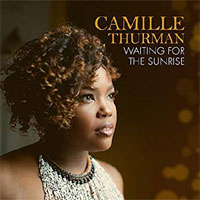Camille Thurman • Waiting for the Sunrise
 ry
to name two influential female saxophonists from the golden era of jazz. I said female.
If you can come up with more than one, then call yourself a serious jazz aficionado.
The only performer I could think of is Vi Redd, the amazing 1950s-era alto player who not
only had the chops to get a regular spotlight with Count Basie but could also belt out a
blues-and-swing number with the full force of a Bessie Smith or an Aretha Franklin. ry
to name two influential female saxophonists from the golden era of jazz. I said female.
If you can come up with more than one, then call yourself a serious jazz aficionado.
The only performer I could think of is Vi Redd, the amazing 1950s-era alto player who not
only had the chops to get a regular spotlight with Count Basie but could also belt out a
blues-and-swing number with the full force of a Bessie Smith or an Aretha Franklin.
More than fifty years after Redd’s heyday, the jazz world finally has another woman who can sing as well as she plays her horn. Saxophonist and singer Camille Thurman uses her four-octave vocal range to conjure up the ghosts of Ella Fitzgerald and Sarah Vaughan and her prodigious breath control to produce a tenor sound that falls somewhere between the power of Dexter Gordon and the breathy seduction of Joe Lovano. Hailing from Queens, New York, the 31-year-old Thurman released her first two studio albums back in 2014 after an outstanding performance in the Sarah Vaughan International Jazz Competition garnered press attention. Waiting for the Sunrise is her fourth album and second release for the Chesky label. One of this set’s strongest tracks is Thurman’s cover of Harry Warren and Al Dubin’s "September in the Rain." Thurman splits the difference between Sinatra’s famous romantic rendition and Dinah Washington’s R&B-tinged treatment of this classic. It’s a savvy choice by a singer who is becoming increasingly comfortable interpreting other people’s work. The way Thurman takes her sweet time with Hoagy Carmichael’s "The Nearness of You" is further evidence of a maturity that belies her relative youth. When she leans in for some lusciously lyrical sax lines in the middle of the piece, I can’t imagine any romantic couple not scooting a bit closer. While the mood of these sessions is intentionally light and airy, a few cuts like "Tarde" and "I Just Found Out About Love" could use more energy. Waiting for the Sunrise is part of Chesky's binaural series of recordings made with a special Theoretica Applied Physics binaural microphone placed inside the "ears" of a B&K 4128-C dummy head -- a recording technique that the label’s press materials say creates a more immersive 360-degree sound experience for headphone listeners. Regular TAB readers will know that I've had a mixed reaction to some previous Chesky binaural releases. Series producer David Chesky and I exchanged a few e-mails about this last year. We agreed that some listeners like me tend to prefer recordings made in what he calls a "dry" or less reactive acoustic environment, as opposed to some of the "wet" venues he has used for a number of binaural-series sessions. At the time of our discussion, Mr. Chesky was about to record Thurman’s previous album, Inside the Moment [Chesky JD397], at New York City’s Rockwood Music Hall. True to his prediction, I fell in love with that recording. On my system, the performers seemed palpably present and the mood of the venue was energetic. Some of the solos sounded realistic enough to make me jump with surprise. It’s spooky how much of the event’s excitement Mr. Chesky managed to capture with one microphone. By contrast, this year’s Waiting for the Sunrise was recorded at a decommissioned church now known as the Hirsch Center in Brooklyn, and I doubt you could find a more "wet" recording venue if you tried. On this outing, Thurman and her band are enveloped by the cavernous venue’s considerable echo and ambience. While Waiting for the Sunrise is subtly entertaining through my Grado SR-325i headphones, that laid-back approach sounds less integrated and is less engaging through my Wilson Sasha 2 speakers and several other distinctly different two-channel systems I used for auditioning. This is in stark contrast to 2017’s Inside the Moment, which sounds stunningly holographic on speakers as well as headphones. Here’s what I mean: When Jeremy Pelt’s trumpet comes in during Cole Porter’s "So Easy To Love," I find myself wondering why he would be playing from the Hirsch Center’s uppermost tier (I doubt he actually was there). On headphones, the placement of Pelt’s trumpet is somewhat distant, but it’s not nearly as puzzling as it is when heard through speakers. The binaural approach yield’s an entirely different result on two-channel speakers when it comes to conveying percussion. Drummer Steve Williams’ brush work is downright intrusive on "If You Really Love Me" and his rim percussion attracts too much attention during "Some of These Days." My theory is that using a single microphone to manage the reverberations of a modern drum kit in an old church’s lively acoustic environment must be wickedly difficult. I realize my visceral reaction to the binaural recording
techniques employed here is a matter of personal taste, but I can only report what I
prefer. I long for Mr. Chesky and his crew to return with Thurman to Rockwood Music Hall
for another blazing set of the bebop and scat gospel this gifted performer is spreading to
a new generation of jazz fans. |
